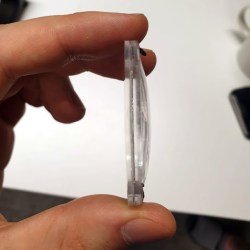
Want to see what exactly is inside the $500 (headset only price) Valve Index VR headset that was released last summer? Take a look at this teardown by [Ilja Zegars]. Not only does [Ilja] pull the device apart, but he identifies each IC and takes care to point out some of the more unique hardware aspects like the fancy diffuser on the displays, and the unique multilayered lenses (which are much thinner than one might expect.)
[Ilja] is no stranger to headset hardware design, and in addition to all the eye candy of high-res photographs, provides some insightful commentary to help make sense of them. The “tracking webs” pulled from the headset are an interesting bit, each is a long run of flexible PCB that connects four tracking sensors for each side of the head-mounted display back to the main PCB. These sensors are basically IR photodiodes, and detect the regular laser sweeps emitted by the base stations of Valve’s lighthouse tracking technology. [Ilja] also gives us a good look at the rod and spring mechanisms seen above that adjust distance between the two screens.
Want more? [Ilja] also has a gallery of high-resolution images available for those you who fancy a closer look. Also, if you missed it, we covered an examination of the Index’s optical design as part of everything you probably didn’t know about field of view in head-mounted displays.
[via Twitter]
















I was somewhat surprised by the number of microcontrollers used in this thing. It’s not entirely clear to me why they needed a USB3 to USB2 interface chip when the 4 port USB3 hub from microchip says “The SuperSpeed hub feature controller operates in parallel with the USB 2.0 controller, decoupling the 5 Gbps SS data transfers from bottlenecks due to the slower USB 2.0 traffic.” in the datasheet, but I suppose the reason is that this still would negatively affect bandwidth.
Most likely they wanted a dedicated USB2 bus that is guaranteed to not share bandwidth with other USB 2.0 devices connected to the PC. To prevent complaints from users because they also plugged in a 768kHz 32 bit surround sound system that’s hogging the USB bus.
First run VCRs vs last days VCRs. VR has a ways to go.
I’m really glad someone else tore this down publicly, so I don’t have to go spelunking in my own!
Interesting how many radios are in there. Including a bluetooth radio just for power management on the Lighthouse is a nice touch, but I’m a little surprised they don’t just require the user to have a compatible BT module on their computer for that feature.
Because that can be a nightmare since manufacturers love to change BT chipsets in their donglings while keeping model number/name, just like with routers and Wi-Fi/SoC.
Same shit back in the early PS3 days too, since when using a PS3 joypad with a computer used to require specific Bluetooth chipsets and drivers for it.
The two expensive ones I bought which people said were compatible turned out to be revised to have a crappy incompatible one, while the old Jabra one I bought to sync shit with my Sony Ericsson W810i somehow just werked.
I honestly thought that one was so old it was incompatible, but guess I got proven wrong huh.
Ditto, got a big old thumbdrive sized Jabra that just works with everything. I’d wish for three more of them, but if I was gonna get a wish granted, I’d want same but nano size.
I’ve seen scalpers sell them at stupid high prices before Bluetooth 4.0 got commonplace, simply due to they were the among the only ones that was also suitable for hackintosh builds if you wanted Bluetooth.
It’s all a bit bizarre.
is there any hack progression for the little Steam Link ?
I noticed there isn’t info on an audio processing chip in the teardown